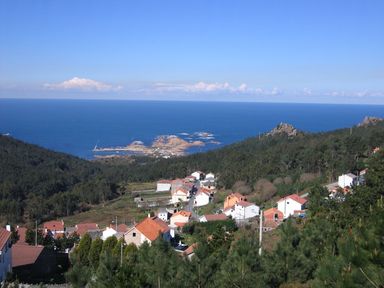Santa Mariña

MONASTERY OF SANTA MARIÑA DE TOSTO
The historian Chao Espina comments that in Arou and in Camelle (A Coruña) there is a so-called “Assembly of Nordemán” and that there the children have blond hair and blue eyes like the people of the North, but as they grow up, they darken. The Viking invasions of Galicia took place between the 8th and 11th centuries. The Vikings were probably the first people to destroy the Monastery of Santa Mariña de Tosto. This story revolves around the black monks (Benedictines) and the Vikings.
According to the General Chronicle of the order of San Benito de Antonio Yepes, published in 1603:
“Santa Mariña de Tosto is a church that is now at the end of the land of Soneira, located between Mugía and Malpica, between very rough mountains and peaks, it was Benitos Monks, but the principle of its foundation is unknown, other than it was a very rich Abbey, because Santa Mariña is patron of that place, performed great miracles, for which the locals of the area held that monastery in great devotion, and offered it many gifts, these were the cause of their downfall, because of wars, and enemies of the fame of their wealth attempted to steal it, and they had their way.”

In the year 1008 the sisters of Doña Eyloza and Doña Sancha had robbed the monastery with their servants. With the monastery being destroyed for the second time, Yepes narrates:
“The Monastery destroyed for the second time, and afterwards was rebuilt in the Era of twelve hundred and three when Don Fernando was King of Castille and Don Gómez González was Count of Galicia and Don Pedro González. The Abbot of San Payo, having been removed from his post, and first marking out the property, rebuilt it in the year twelve hundred and thirty-two, monks were sent again, who attended the service of the Temple of Santa Mariña, where many miracles were always performed.”
In a parchment from 1194 which corresponds to a latter of donation from the abbot of the Monastery of San Pelayo de Antealtares, he undertakes to restore said monastery and donate a series of terms and bequeathments from San Simón de Nande, San Martín de Caratoña, San Cristoval de Carnés and San Pedro de Leis, as far as the sea.
“But in the end it was lost again with wars, and deaths, which happened in the land. The cloisters were ruined, the church has remained,” writes Antonio Yepes in his chronicle.







 —AUDIORELATO: VESTIGIOS FACIALES —
—AUDIORELATO: VESTIGIOS FACIALES —